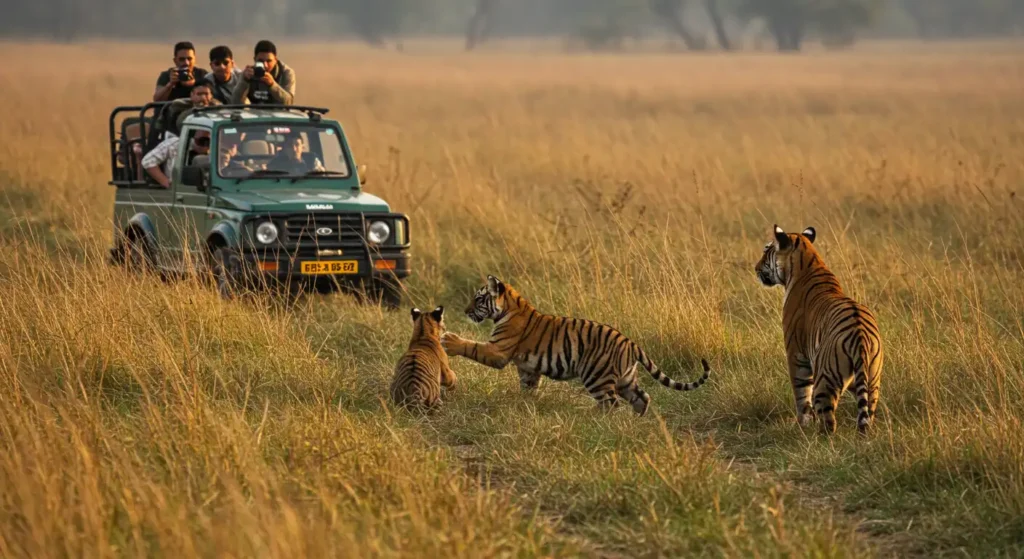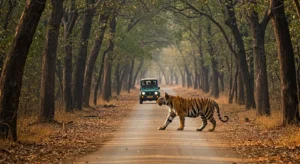If you are a nature lover or an adventure seeker, Dudhwa National Park is one destination that deserves to be on your travel list. Nestled in the Terai region of Uttar Pradesh, this park is a hidden gem of India’s wildlife tourism. From majestic tigers and one-horned rhinos to rare migratory birds, Dudhwa offers an experience that feels both raw and magical.
Whether you are planning your first Dudhwa safari or just curious about this unique national park in Uttar Pradesh, this guide will cover everything you need to know — location, how to reach, best time to visit, safari options, stay choices, and more.
Introduction to Dudhwa National Park

Established in 1977, Dudhwa National Park is part of the larger Dudhwa Tiger Reserve, which also includes Kishanpur and Katarniaghat wildlife sanctuaries. Spread over 490 square kilometers, it is home to dense Sal forests, grasslands, marshes, and rivers that support a rich variety of wildlife.
The park is famous for its tiger population, the reintroduction of the one-horned rhinoceros, and large herds of swamp deer (Barasingha). It is also a paradise for birdwatchers, with more than 400 species of resident and migratory birds.
Location & Geography
Still wondering where is Dudhwa National Park? It is located in the Lakhimpur Kheri district of Uttar Pradesh, right along the border of Nepal. Officially, Dudhwa National Park is located in the state of Uttar Pradesh, India.
- Coordinates: 28.5° N, 80.5° E
- State: Dudhwa National Park is located in the state of Uttar Pradesh
- Landscape: Dense forests, grasslands, wetlands, and the Sharda river
Its proximity to Nepal adds to its uniqueness, as the forest corridor connects with Royal Bardia National Park in Nepal, making it an important cross-border habitat for tigers and elephants.
The park covers nearly 490 square kilometers and is part of the larger Dudhwa Tiger Reserve, which also includes Kishanpur and Katarniaghat wildlife sanctuary. The geography here is diverse:
- Grasslands: Perfect for spotting swamp deer and rhinoceros.
- Dense Sal Forests: Home to tigers, leopards, and elephants.
- Wetlands and Swamps: Ideal for birdwatching, including migratory species.
This unique combination makes Dudhwa one of the richest biodiversity zones in North India.
How to Reach Dudhwa National Park (Road, Rail, Air)
If you are planning your first trip, check our detailed guide on how to reach Dudhwa National Park by road, rail, and air. Here’s a simple breakdown:
- By Road: Dudhwa is well-connected by road from Lucknow (230 km), Delhi (430 km), and Bareilly (180 km). Buses and taxis are available.
- By Rail: The nearest railway station is Dudhwa Railway Station, just 4 km from the park. Alternatively, Palia Kalan station is also nearby.
- By Air: The nearest airport is Chaudhary Charan Singh Airport (Lucknow), around 230 km away. From there, taxis and buses are available to Dudhwa.
Pro Tip: If traveling from Delhi, an overnight train or road trip makes the journey convenient.
Safari Options in Dudhwa National Park (Jeep, Elephant, Rhino)
A trip to Dudhwa is incomplete without experiencing the thrill of a Dudhwa safari. Visitors can choose from multiple options:
- Jeep Safari: The most popular way to explore Dudhwa. Jeeps take you deep into the forest where you can spot tigers, swamp deer, and elephants.
- Elephant Safari: A unique experience where you ride on elephants to cover swampy areas. Best for rhino sightings.
- Rhino Safari (Sonaripur Range): This special zone was created for the reintroduced one-horned rhinoceros. A must-do for wildlife lovers.
For a smooth experience, advance Dudhwa safari booking is highly recommended, especially during peak seasons.
Best Time to Visit Dudhwa
The park is open from November to June, The park is open from November to June, but the best time to visit Dudhwa National Park depends on your travel preferences.
- Winter (November – February): Pleasant weather, great for birdwatching and photography.
- Summer (March – June): Hot, but better chances of spotting tigers and other big mammals near water bodies.
Most travelers prefer winter for comfort, but wildlife photographers often choose summer for clear sightings.
Where to Stay Near Dudhwa National Park
Accommodation around Dudhwa ranges from forest lodges to eco-friendly resorts. Popular options include:
- Forest Rest Houses (Inside Park): Simple and affordable, but must be booked through forest officials.
- Eco Resorts & Hotels (Outside Park): Offer better amenities, local cuisine, and safari packages.
- Homestays: Great for cultural experiences with locals.
Staying closer to the main gate ensures you get the best safari slots early in the morning.
For more details on resorts, forest lodges, and eco-stays, check our dedicated page on accommodation in Dudhwa National Park
Essential Travel Tips for Tourists
To make your Dudhwa tourism experience smooth and enjoyable, keep these tips in mind:
- Always carry a valid ID for safari bookings.
- Wear neutral-colored clothes (green, brown, beige) to blend with the jungle.
- Carry binoculars and a camera for bird and wildlife spotting.
- Do not litter inside the park — it is strictly against eco-tourism rules.
- Safaris start early in the morning and in the afternoon — reach the gate at least 30 minutes in advance.
- Respect wildlife—avoid loud noises or feeding animals.
- Book safaris and accommodations well in advance.
A little preparation goes a long way in making your Dudhwa trip unforgettable.
Why Dudhwa is a Hidden Gem
Unlike popular parks like Jim Corbett or Ranthambore, Dudhwa National Park is still less crowded, which makes it more peaceful and authentic. Here, safaris feel like true wilderness exploration rather than a touristy outing.
From its rare wildlife to its raw landscapes, Dudhwa is a reminder of what Indian forests used to be — untamed, vibrant, and full of life. If you’re looking for a mix of adventure and serenity, Dudhwa is waiting to surprise you.
For those asking, is Dudhwa worth visiting? — the answer is a big YES. It’s not just a park; it’s a journey into the heart of nature.
FAQs
What is Dudhwa National Park famous for?
Dudhwa is famous for its tiger population, one-horned rhinos, swamp deer, and migratory birds. It is also known for its untouched natural beauty compared to other crowded parks.
Is Dudhwa better in winter or summer?
Winter (Nov–Feb) is best for pleasant weather and birdwatching. Summer (Mar–June) is hotter but offers higher chances of spotting tigers and rhinos.
How many days are enough for Dudhwa trip?
A 2–3 day trip is perfect to cover at least two safaris, explore nearby villages, and enjoy the local culture.

